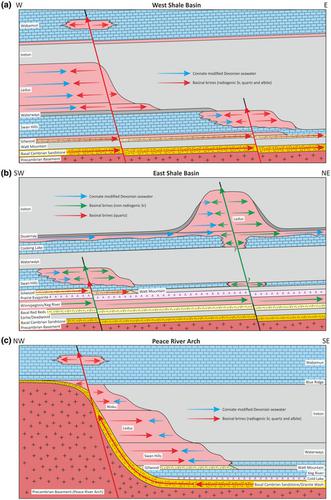当前位置:
X-MOL 学术
›
Basin Res.
›
论文详情
Our official English website, www.x-mol.net, welcomes your feedback! (Note: you will need to create a separate account there.)
Burial dolomitization driven by modified seawater and basal aquifer‐sourced brines: Insights from the Middle and Upper Devonian of the Western Canadian Sedimentary Basin
Basin Research ( IF 3.2 ) Pub Date : 2020-07-01 , DOI: 10.1111/bre.12489 Jack Stacey 1 , Cathy Hollis 1 , Hilary Corlett 2 , Ardiansyah Koeshidayatullah 1
Basin Research ( IF 3.2 ) Pub Date : 2020-07-01 , DOI: 10.1111/bre.12489 Jack Stacey 1 , Cathy Hollis 1 , Hilary Corlett 2 , Ardiansyah Koeshidayatullah 1
Affiliation

|
Dolomitization in the Western Canadian Sedimentary Basin has been extensively researched, producing vast geochemical datasets. This provides a unique opportunity to assess the regional sources and flux of dolomitizing fluids on a larger scale than previous studies. A meta‐analysis was conducted on stable isotope, strontium isotope (87Sr/86Sr), fluid inclusion and lithium‐rich formation water data published over 30 years, with new petrographic, X‐ray diffraction, stable isotope and rare‐earth element (REE+Y) data. The Middle to Upper Devonian Swan Hills Formation, Leduc Formation and Wabamun Group contain replacement dolomite (RD) cross‐cut by stylolites, suggesting replacement dolomitization occurred during shallow burial. Stable isotope, REE+Y and 87Sr/86Sr data indicate RD formed from Devonian seawater, then recrystallized during burial. Apart from the Wabamun Group of the Peace River Arch (PRA), saddle dolomite cement (SDC) is more δ18O(PDB) depleted than RD, and cross‐cuts stylolites, suggesting precipitation during deep burial. SDC 87Sr/86Sr data indicate contributions from 87Sr‐rich basinal brines in the West Shale Basin (WSB) and PRA, and authigenic quartz/albite suggests basinal brines interacted with underlying clastic aquifers before ascending faults into carbonate strata. The absence of quartz/albite within dolomites of the East Shale Basin (ESB) suggests dolomitizing fluids only interacted with carbonate strata. We conclude that replacement dolomitization resulted from connate Devonian seawater circulating through aquifers and faults during shallow burial. SDC precipitated during deep burial from basinal brines sourced from basal carbonates (ESB) and clastic aquifers (WSB, PRA). Lithium‐rich formation waters suggest basinal brines originated as residual evapo‐concentrated Middle Devonian seawater that interacted with basal aquifers and ascended faults during the Antler and Laramide Orogenies. These results corroborate those of previous studies but are verified by new integrated analysis of multiple datasets. New insights emphasize the importance of basal aquifers and residual evapo‐concentrated seawater in dolomitization, which is potentially applicable to other regionally dolomitized basins.
中文翻译:

改良海水和基底含水层卤水驱动的埋藏白云石化作用:来自加拿大西部沉积盆地中上泥盆统的见解
加拿大西部沉积盆地的白云石化已得到广泛研究,产生了大量的地球化学数据集。与以往的研究相比,这提供了一个独特的机会来更大规模地评估白云石化流体的区域来源和通量。对30年来发表的稳定同位素,锶同位素(87 Sr / 86 Sr),流体包裹体和富含锂的地层水数据进行了荟萃分析,并采用了新的岩石学,X射线衍射,稳定同位素和稀土元素(REE + Y)数据。中上泥盆纪天鹅山组,勒杜克组和瓦巴门组含有由白云母横切的置换白云石(RD),表明在浅埋期间发生了置换白云石化作用。稳定同位素,REE + Y和87 Sr /86 Sr数据表明RD是从泥盆纪海水中形成的,然后在埋藏过程中重结晶。除了和平河拱的沃伯门集团(PRA),鞍白云石水泥(SDC)更δ 18 Ø (PDB)消耗比RD和十字切口缝合线,这表明深埋藏过程中沉淀。SDC 87 Sr / 86 Sr数据表明来自87西页岩盆地(WSB)和PRA中富含锶的盆地盐水,以及自生石英/阿尔比特,表明盆地盐水在将断层提升到碳酸盐岩层之前先与下伏的碎屑含水层相互作用。东页岩盆地(ESB)的白云岩中没有石英/ bitbites,这表明白云石化流体仅与碳酸盐岩地层相互作用。我们得出结论,置换白云石化是由于浅埋期间在含水层和断层中循环的天然泥盆纪海水引起的。在深埋期间,SDC沉淀来自基底碳酸盐岩(ESB)和碎屑含水层(WSB,PRA)的盆地盐水。富含锂的地层水表明盆地盐水起源于残留的蒸发浓缩的中泥盆纪海水,在鹿特勒和拉拉米德造山运动中与基底含水层相互作用并上升了断层。这些结果证实了先前的研究结果,但已通过对多个数据集的新综合分析得到了验证。新的见解强调了基层含水层和残留的蒸发浓缩海水在白云石化中的重要性,这可能适用于其他区域白云石化盆地。
更新日期:2020-07-01
中文翻译:

改良海水和基底含水层卤水驱动的埋藏白云石化作用:来自加拿大西部沉积盆地中上泥盆统的见解
加拿大西部沉积盆地的白云石化已得到广泛研究,产生了大量的地球化学数据集。与以往的研究相比,这提供了一个独特的机会来更大规模地评估白云石化流体的区域来源和通量。对30年来发表的稳定同位素,锶同位素(87 Sr / 86 Sr),流体包裹体和富含锂的地层水数据进行了荟萃分析,并采用了新的岩石学,X射线衍射,稳定同位素和稀土元素(REE + Y)数据。中上泥盆纪天鹅山组,勒杜克组和瓦巴门组含有由白云母横切的置换白云石(RD),表明在浅埋期间发生了置换白云石化作用。稳定同位素,REE + Y和87 Sr /86 Sr数据表明RD是从泥盆纪海水中形成的,然后在埋藏过程中重结晶。除了和平河拱的沃伯门集团(PRA),鞍白云石水泥(SDC)更δ 18 Ø (PDB)消耗比RD和十字切口缝合线,这表明深埋藏过程中沉淀。SDC 87 Sr / 86 Sr数据表明来自87西页岩盆地(WSB)和PRA中富含锶的盆地盐水,以及自生石英/阿尔比特,表明盆地盐水在将断层提升到碳酸盐岩层之前先与下伏的碎屑含水层相互作用。东页岩盆地(ESB)的白云岩中没有石英/ bitbites,这表明白云石化流体仅与碳酸盐岩地层相互作用。我们得出结论,置换白云石化是由于浅埋期间在含水层和断层中循环的天然泥盆纪海水引起的。在深埋期间,SDC沉淀来自基底碳酸盐岩(ESB)和碎屑含水层(WSB,PRA)的盆地盐水。富含锂的地层水表明盆地盐水起源于残留的蒸发浓缩的中泥盆纪海水,在鹿特勒和拉拉米德造山运动中与基底含水层相互作用并上升了断层。这些结果证实了先前的研究结果,但已通过对多个数据集的新综合分析得到了验证。新的见解强调了基层含水层和残留的蒸发浓缩海水在白云石化中的重要性,这可能适用于其他区域白云石化盆地。



























 京公网安备 11010802027423号
京公网安备 11010802027423号